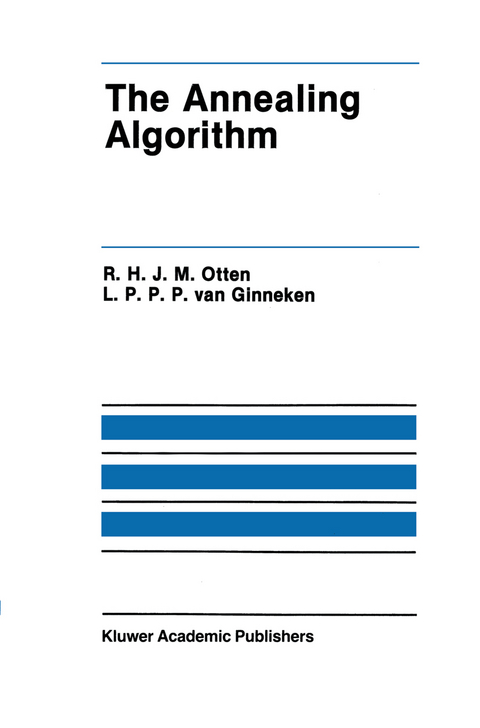
The Annealing Algorithm
Springer-Verlag New York Inc.
978-1-4612-8899-2 (ISBN)
The goal of the research out of which this monograph grew, was to make annealing as much as possible a general purpose optimization routine. At first glance this may seem a straight-forward task, for the formulation of its concept suggests applicability to any combinatorial optimization problem. All that is needed to run annealing on such a problem is a unique representation for each configuration, a procedure for measuring its quality, and a neighbor relation. Much more is needed however for obtaining acceptable results consistently in a reasonably short time. It is even doubtful whether the problem can be formulated such that annealing becomes an adequate approach for all instances of an optimization problem. Questions such as what is the best formulation for a given instance, and how should the process be controlled, have to be answered. Although much progress has been made in the years after the introduction of the concept into the field of combinatorial optimization in 1981, some important questions still do not have a definitive answer. In this book the reader will find the foundations of annealing in a self-contained and consistent presentation. Although the physical analogue from which the con cept emanated is mentioned in the first chapter, all theory is developed within the framework of markov chains. To achieve a high degree of instance independence adaptive strategies are introduced.
1 The Annealing Algorithm: A Preview.- 1.1 Combinatorial optimization.- 1.2 Moves and local minima.- 1.3 Hill climbing.- 1.4 Simulated annealing.- 1.5 Applications.- 1.6 Mathematical model.- 1.7 Discussion.- 2 Preliminaries from Matrix Theory.- 2.1 Matrices. Notation and basic properties.- 2.2 Pseudo-diagonal normal forms.- 2.3 Norms and limits of matrices.- 2.4 Quadratic forms.- 2.5 Discussion.- 3 Chains.- 3.1 Terminology.- 3.2 Linear arrangement, an example.- 3.3 The chain limit theorem.- 3.4 Reversible chains.- 3.5 Discussion.- 4 Chain Statistics.- 4.1 Density Functions.- 4.2 Expected values.- 4.3 Sampling.- 4.4 Maximum likelyhood densities.- 4.5 Aggregate functions.- 4.6 Discussion.- 5 Annealing Chains.- 5.1 Towards low scores.- 5.2 Maximal accessibility.- 5.3 The acceptance function.- 5.4 Properties of annealing chains.- 5.5 Discussion.- 6 Samples from Normal Distributions.- 6.1 Characteristic functions.- 6.2 Quadratic forms and characteristic functions.- 6.3 Sampling distributions.- 6.4 Asymptotic properties of sampling distributions.- 6.5 Discussion.- 7 Score Densities.- 7.1 The density of states.- 7.2 Weak control.- 7.3 Strong control.- 7.4 Three parameter aggregates.- 7.5 Discussion.- 8 The Control Parameter.- 8.1 Initialization.- 8.2 Decrements in the control parameter.- 8.3 A stop criterion.- 8.4 Proper convergence.- 8.5 Discussion.- 9 Finite-Time Behavior of the Annealing Algorithm.- 9.1 Rate of convergence of chains.- 9.2 Minimum number of iterations.- 9.3 Finite-time optimal schedules.- 9.4 Discussion.- 10 The Structure of the State Space.- 10.1 Chain convergence.- 10.2 The topography of the state space.- 10.3 The set of moves.- 10.4 Global convergence.- 10.5 Discussion.- 11 Implementation Aspects.- 11.1 An implementation.- 11.2 The selection function.- 11.3 Other speed-up methods.- References.
| Reihe/Serie | The Springer International Series in Engineering and Computer Science ; 72 |
|---|---|
| Zusatzinfo | XII, 202 p. |
| Verlagsort | New York, NY |
| Sprache | englisch |
| Maße | 155 x 235 mm |
| Themenwelt | Sachbuch/Ratgeber ► Natur / Technik ► Garten |
| Informatik ► Weitere Themen ► CAD-Programme | |
| Mathematik / Informatik ► Mathematik ► Graphentheorie | |
| Technik ► Elektrotechnik / Energietechnik | |
| ISBN-10 | 1-4612-8899-1 / 1461288991 |
| ISBN-13 | 978-1-4612-8899-2 / 9781461288992 |
| Zustand | Neuware |
| Haben Sie eine Frage zum Produkt? |
aus dem Bereich


